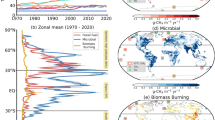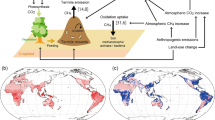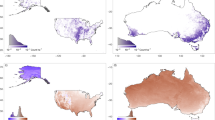Abstract
Landfill methane (CH4) emissions account for ~10% of all anthropogenic CH4 emissions globally, amounting to ~50 Tg per year. The current emission inventories utilize a first-order decay model as recommended by the Intergovernmental Panel on Climate Change. In contrast to recent top-down atmospheric inversion results, the mainstream bottom-up inventories exhibit significant biases, largely stemming from the inaccuracy in the a priori decay constant (k), an essential rate-controlling parameter in the model. We improve the k estimation method by incorporating compositional- and environmental-specific corrections, which are readily integrated into the Intergovernmental Panel on Climate Change’s model. The accuracy of CH4 emission predictions is significantly improved by using the corrected k values, which are benchmarked against the atmospheric inversion results. We extend the emission estimations to landfills worldwide and reveal up to 200% underestimations for individual landfills. Our findings highlight the importance of prioritizing landfill CH4 emission monitoring and reduction as one of the most cost-effective mitigation options to achieve current climate goals.
This is a preview of subscription content, access via your institution
Access options
Access Nature and 54 other Nature Portfolio journals
Get Nature+, our best-value online-access subscription
$29.99 / 30 days
cancel any time
Subscribe to this journal
Receive 12 digital issues and online access to articles
$119.00 per year
only $9.92 per issue
Buy this article
- Purchase on Springer Link
- Instant access to full article PDF
Prices may be subject to local taxes which are calculated during checkout





Similar content being viewed by others
Data availability
All data supporting the findings of this study are available within the paper and its supplementary files. The public data used in this paper were obtained from the Emissions Database for Global Atmospheric Research (EDGAR) (v.8.0, https://edgar.jrc.ec.europa.eu/dataset_ghg80), the UNFCCC Greenhouse Gas Data Interface (https://di.unfccc.int/), the Climate Watch Database (https://www.climatewatchdata.org/ghg-emissions), the LMOP landfill and project database (https://www.epa.gov/lmop/lmop-landfill-and-project-database) and the Database of Global Administrative Areas (https://gadm.org/index.html).
References
Cai, B. et al. CH4 mitigation potentials from China landfills and related environmental co-benefits. Sci. Adv. 4, eaar8400 (2018).
Zhu, J. et al. Cradle-to-grave emissions from food loss and waste represent half of total greenhouse gas emissions from food systems. Nat. Food 4, 247–256 (2023).
Saunois, M. et al. The global methane budget 2000–2017. Earth Syst. Sci. Data 12, 1561–1623 (2020).
Maasakkers, J. D. et al. Using satellites to uncover large methane emissions from landfills. Sci. Adv. 8, eabn9683 (2022).
Kaza, S., Yao, L., Bhada-Tata, P. & Van Woerden, F. What a Waste 2.0: A Global Snapshot of Solid Waste Management to 2050 (World Bank, 2018); http://hdl.handle.net/10986/30317
Lauvaux, T. et al. Global assessment of oil and gas methane ultra-emitters. Science 375, 557–561 (2022).
Global Non-CO2 Greenhouse Gas Emission Projections & Mitigation 2015–2050 67–71 (Environmental Protection Agency, Office of Atmospheric Programs, 2019).
Du, W.-J. et al. Spatiotemporal pattern of greenhouse gas emissions in China’s wastewater sector and pathways towards carbon neutrality. Nat. Water 1, 166–175 (2023).
Song, C. et al. Methane emissions from municipal wastewater collection and treatment systems. Environ. Sci. Technol. 57, 2248–2261 (2023).
Fei, X., Fang, M. & Wang, Y. Climate change affects land-disposed waste. Nat. Clim. Change 11, 1004–1005 (2021).
IPCC Guidelines for National Greenhouse Gas Inventories (eds Eggleston, H. S. et al.) (IGES, 2006).
2019 Refinement to the 2006 IPCC Guidelines for National Greenhouse Gas Inventories (IPCC, 2019); https://www.ipcc-nggip.iges.or.jp/public/2019rf/vol5.html
Krause, M. J., Chickering, G. W., Townsend, T. G. & Reinhart, D. R. Critical review of the methane generation potential of municipal solid waste. Crit. Rev. Environ. Sci. Technol. 46, 1117–1182 (2016).
Spokas, K., Bogner, J., Corcoran, M. & Walker, S. From California dreaming to California data: challenging historic models for landfill CH4 emissions. Elementa 3, 000051 (2015).
Erland, B. M., Thorpe, A. K. & Gamon, J. A. Recent advances toward transparent methane emissions monitoring: a review. Environ. Sci. Technol. 56, 16567–16581 (2022).
Deng, Z. et al. Comparing national greenhouse gas budgets reported in UNFCCC inventories against atmospheric inversions. Earth Syst. Sci. Data 14, 1639–1675 (2022).
Wang, X., Nagpure, A. S., DeCarolis, J. F. & Barlaz, M. A. Characterization of uncertainty in estimation of methane collection from select U.S. landfills. Environ. Sci. Technol. 49, 1545–1551 (2015).
Daniels, W. S. et al. Toward multiscale measurement-informed methane inventories: reconciling bottom-up site-level inventories with top-down measurements using continuous monitoring systems. Environ. Sci. Technol. 57, 11823–11833 (2023).
NASEM Improving Characterization of Anthropogenic Methane Emissions in the United States (National Academies Press, 2018).
Lu, X. et al. Methane emissions in the United States, Canada, and Mexico: evaluation of national methane emission inventories and 2010–2017 sectoral trends by inverse analysis of in situ (GLOBALVIEWplus CH4 ObsPack) and satellite (GOSAT) atmospheric observations. Atmos. Chem. Phys. 22, 395–418 (2022).
Jang, Y.-S., Kim, Y.-W. & Lee, S.-I. Hydraulic properties and leachate level analysis of Kimpo metropolitan landfill, Korea. Waste Manage. (Oxf.) 22, 261–267 (2002).
Duren, R. M. et al. California’s methane super-emitters. Nature 575, 180–184 (2019).
De la Cruz, F. B. et al. Comparison of field measurements to methane emissions models at a new landfill. Environ. Sci. Technol. 50, 9432–9441 (2016).
Delgado, M., López, A., Esteban-García, A. L. & Lobo, A. The importance of particularising the model to estimate landfill GHG emissions. J. Environ. Manage. 325, 116600 (2023).
Krause, M. J., Chickering, G. W. & Townsend, T. G. Translating landfill methane generation parameters among first-order decay models. J. Air Waste Manage. Assoc. 66, 1084–1097 (2016).
Karanjekar, R. V. et al. Estimating methane emissions from landfills based on rainfall, ambient temperature, and waste composition: the CLEEN model. Waste Manage. (Oxf.) 46, 389–398 (2015).
He, H. & Fei, X. Scaling up laboratory column testing results to predict coupled methane generation and biological settlement in full-scale municipal solid waste landfills. Waste Manage. (Oxf.) 115, 25–35 (2020).
Yazdani, R., Barlaz, M. A., Augenstein, D., Kayhanian, M. & Tchobanoglous, G. Performance evaluation of an anaerobic/aerobic landfill-based digester using yard waste for energy and compost production. Waste Manage. (Oxf.) 32, 912–919 (2012).
Pezzolla, D. et al. Optimization of solid-state anaerobic digestion through the percolate recirculation. Biomass Bioenergy 96, 112–118 (2017).
Huang, F.-S., Hung, J.-M. & Lu, C.-J. Enhanced leachate recirculation and stabilization in a pilot landfill bioreactor in Taiwan. Waste Manage. Res. 30, 849–858 (2012).
Fei, X., Zekkos, D. & Raskin, L. Quantification of parameters influencing methane generation due to biodegradation of municipal solid waste in landfills and laboratory experiments. Waste Manage. (Oxf.) 55, 276–287 (2016).
Jain, P., Wally, J., Townsend, T. G., Krause, M. & Tolaymat, T. Greenhouse gas reporting data improves understanding of regional climate impact on landfill methane production and collection. PLoS ONE 16, e0246334 (2021).
Tu, Q. et al. Quantification of CH4 emissions from waste disposal sites near the city of Madrid using ground- and space-based observations of COCCON, TROPOMI and IASI. Atmos. Chem. Phys. 22, 295–317 (2022).
Fei, X. et al. The long-term fates of land-disposed plastic waste. Nat. Rev. Earth Environ. 3, 733–735 (2022).
Guidelines for Evaluating the Post-closure Care Period for Hazardous Waste Disposal Facilities under Subtitle C of RCRA (EPA, 2016); https://www.epa.gov/sites/default/files/2017-01/documents/pcc_guidance_508_withdateandletterhead.pdf
IPCC: Summary for Policymakers. in Climate Change 2023: Synthesis Report (eds Core Writing Team et al.) (IPCC, 2023).
Höglund-Isaksson, L., Gómez-Sanabria, A., Klimont, Z., Rafaj, P. & Schöpp, W. Technical potentials and costs for reducing global anthropogenic methane emissions in the 2050 timeframe—results from the GAINS model. Environ. Res. Commun. 2, 025004 (2020).
Jaramillo, P. & Matthews, H. S. Landfill-gas-to-energy projects: analysis of net private and social benefits. Environ. Sci. Technol. 39, 7365–7373 (2005).
Johari, A., Ahmed, S. I., Hashim, H., Alkali, H. & Ramli, M. Economic and environmental benefits of landfill gas from municipal solid waste in Malaysia. Renew. Sustain. Energy Rev. 16, 2907–2912 (2012).
Spokas, K., Bogner, J. & Corcoran, M. Modeling landfill CH4 emissions: CALMIM international field validation, using CALMIM to simulate management strategies, current and future climate scenarios. Elementa 9, 00050 (2021).
LMOP Landfill and Project Database (EPA, 2023); https://www.epa.gov/lmop/lmop-landfill-and-project-database
Powell, J. T., Pons, J. C. & Chertow, M. Waste informatics: establishing characteristics of contemporary US landfill quantities and practices. Environ. Sci. Technol. 50, 10877–10884 (2016).
MATLAB version: 9.9.0 (R2020b). The MathWorks Inc. (2020).
Origin version: 2021. OriginLab Corporation (2021).
Hanson, J. L., Yeşiller, N. & Oettle, N. K. Spatial and temporal temperature distributions in municipal solid waste landfills. J. Environ. Eng. 136, 804–814 (2010).
Zhang, T., Shi, J., Qian, X. & Ai, Y. Temperature and gas pressure monitoring and leachate pumping tests in a newly filled MSW layer of a landfill. Int. J. Environ. Res. 13, 1–19 (2019).
Cai, Y., Cai, X., Desjardins, R. L., Worth, D. E. & Srinivasan, R. Methane emissions from a waste treatment site: numerical analysis of aircraft-based data. Agric. For. Meteorol. 292, 108102 (2020).
Cambaliza, M. O. L. et al. Field measurements and modeling to resolve m2 to km2 CH4 emissions for a complex urban source: an Indiana landfill study. Elementa 5, 36 (2017).
Lavoie, T. N. et al. Aircraft-based measurements of point source methane emissions in the Barnett Shale basin. Environ. Sci. Technol. 49, 7904–7913 (2015).
Rosso, L., Lobry, J. & Flandrois, J.-P. An unexpected correlation between cardinal temperatures of microbial growth highlighted by a new model. J. Theor. Biol. 162, 447–463 (1993).
Schupp, S., De La Cruz, F. B., Cheng, Q., Call, D. F. & Barlaz, M. A. Evaluation of the temperature range for biological activity in landfills experiencing elevated temperatures. ACS EST Eng. 1, 216–227 (2020).
Sun, X.-Y., Xu, H., Wu, B.-H., Shen, S.-L. & Zhan, L.-T. A first-order kinetic model for simulating the aerobic degradation of municipal solid waste. J. Environ. Manage. 329, 117093 (2023).
Xiao, D., Chen, Y., Xu, W. & Zhan, L. An aerobic degradation model for landfilled municipal solid waste. Appl. Sci. 11, 7557 (2021).
Hartz, K. & Ham, R. Moisture level and movement effects on methane production rates in landfill samples. Waste Manage. Res. 1, 139–145 (1983).
Qu, X. et al. Anaerobic biodegradation of cellulosic material: batch experiments and modelling based on isotopic data and focusing on aceticlastic and non-aceticlastic methanogenesis. Waste Manage. (Oxf.) 29, 1828–1837 (2009).
Dearman, B. & Bentham, R. Anaerobic digestion of food waste: comparing leachate exchange rates in sequential batch systems digesting food waste and biosolids. Waste Manage. (Oxf.) 27, 1792–1799 (2007).
Wang, Y., Pelkonen, M. & Kaila, J. Effects of temperature on the long-term behaviour of waste degradation, emissions and post-closure management based on landfill simulators. Open Waste Manage. J. 5, 19–27 (2012).
TOOL04 Methodological Tool: Emissions from Solid Waste Disposal Sites (Version 08.0). Clean Development Mechanism (CDM) (UNFCCC, 2017).
Crippa, M. et al. GHG Emissions of All World Countries (JRC, 2021); https://publications.jrc.ec.europa.eu/repository/handle/JRC126363
Climate Watch Data: Historical GHG Emissions (ClimateWatch, 2022); https://www.climatewatchdata.org/ghg-emissions
Gütschow, J. et al. The PRIMAP-hist national historical emissions time series. Earth Syst. Sci. Data 8, 571–603 (2016).
United Nations Framework Convention on Climate Change (UNFCCC) Greenhouse Gas Data Interface (UNFCCC, 2022); https://di.unfccc.int/
Kottek, M., Grieser, J., Beck, C., Rudolf, B. & Rubel, F. World map of the Köppen–Geiger climate classification updated. Meteorol. Z. 15, 259–263 (2006).
Acknowledgements
The authors received no specific funding for this work. We acknowledge Nanyang Technological University, Singapore, for providing research scholarships for this study. We thank the Debris of the Anthropocene to Resources (DotA2) Lab at NTU for their support.
Author information
Authors and Affiliations
Contributions
Yao Wang and X.F. conceptualized the study. Yao Wang, M.F., Z.L., H.H., Y.G., X.P., Yijie Wang and K.Y. collected, analysed and illustrated the data. The manuscript was written by Yao Wang with revisions from all the authors.
Corresponding authors
Ethics declarations
Competing interests
The authors declare no competing interests.
Peer review
Peer review information
Nature Sustainability thanks Broghan Erland, Amaya Lobo and Max Krause for their contribution to the peer review of this work.
Additional information
Publisher’s note Springer Nature remains neutral with regard to jurisdictional claims in published maps and institutional affiliations.
Supplementary information
Supplementary Information
Supplementary Figs. 1–6, Tables 1–7 and Discussion.
Supplementary Data 1
The data used in this paper.
Rights and permissions
Springer Nature or its licensor (e.g. a society or other partner) holds exclusive rights to this article under a publishing agreement with the author(s) or other rightsholder(s); author self-archiving of the accepted manuscript version of this article is solely governed by the terms of such publishing agreement and applicable law.
About this article
Cite this article
Wang, Y., Fang, M., Lou, Z. et al. Methane emissions from landfills differentially underestimated worldwide. Nat Sustain 7, 496–507 (2024). https://doi.org/10.1038/s41893-024-01307-9
Received:
Accepted:
Published:
Issue Date:
DOI: https://doi.org/10.1038/s41893-024-01307-9



